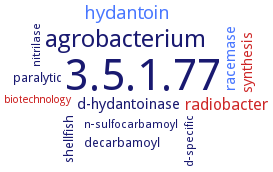3.5.1.77: N-carbamoyl-D-amino-acid hydrolase
This is an abbreviated version!
For detailed information about N-carbamoyl-D-amino-acid hydrolase, go to the full flat file.

Word Map on EC 3.5.1.77 
-
3.5.1.77
-
agrobacterium
-
hydantoin
-
radiobacter
-
d-hydantoinase
-
racemase
-
synthesis
-
decarbamoyl
-
shellfish
-
paralytic
-
d-specific
-
nitrilase
-
n-sulfocarbamoyl
-
biotechnology
- 3.5.1.77
-
agrobacterium
- hydantoin
- radiobacter
- d-hydantoinase
- racemase
- synthesis
-
decarbamoyl
-
shellfish
-
paralytic
-
d-specific
- nitrilase
-
n-sulfocarbamoyl
- biotechnology
Reaction
Synonyms
AcHyuC, Amidase, N-carbamoyl-D-amino acid, BJS_06659, carbamoylase, D-carbamoylase, D-N-alpha-Carbamoylase, D-N-carbamoylase, D-NCAase, Dcase, DCase-M3, DCHase, hyuD, N-carbamoyl D-amino acid amidohydrolase, N-Carbamoyl-D-amino acid amidase, N-carbamoyl-D-amino acid amidohydrolase, N-Carbamyl amino acid amidohydrolase, N-Carbamyl-D-amino acid amidohydrolase
ECTree
Advanced search results
General Stability
General Stability on EC 3.5.1.77 - N-carbamoyl-D-amino-acid hydrolase
Please wait a moment until all data is loaded. This message will disappear when all data is loaded.
high thermal stability and high stability in repeated batch reactions of the immobilized enzyme
-
immobilized enzyme is stabilized by dithiothreitol, L-Cys, cysteamine, and sodium hydrosulfite. After 14times repeated reactions, the remaining activity of the immobilized enzyme cross-linked with 0.1% and 0.2% of glutaraldehyde, and 0.2% of the glutaraldehyde with dithiothreitol in the reaction mixture is 12%, 18%, and 63% respectively
-


 results (
results ( results (
results ( top
top





